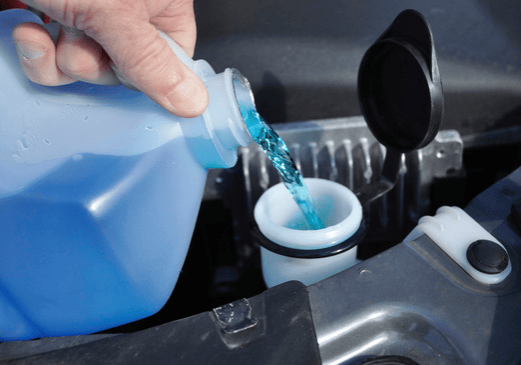
Ford Puma Windshield Washer Not Working — Complete Fix Guide

A fully functional windshield washer is essential for safe driving. When the system on your Ford Puma fails to spray fluid, visibility suffers — and so does safety. Below, we cover every possible cause of a non-working washer system and how to diagnose and fix each one efficiently.
- 🚗 Common Causes of Ford Puma Windshield Washer Failure
- 1. Clogged Windshield Washer Nozzles
- 2. Blown Washer Pump Fuse
- 3. Washer Pump Failure
- 4. Leaking or Disconnected Washer Hose
- 5. Blocked or Pinched Hose
- 6. Frozen Washer Fluid (Cold Weather Issue)
- 7. Faulty Washer Switch or Wiring Fault
- 8. Empty or Cracked Washer Fluid Reservoir
- 🧰 Tools Needed for Diagnosis and Repair
- 🛠️ Step-by-Step Troubleshooting Order
- ✅ Preventive Maintenance Tips
- 🧾 Summary Table
🚗 Common Causes of Ford Puma Windshield Washer Failure
The most frequent causes of washer malfunction in the Ford Puma include:
- Clogged or blocked spray nozzles
- Blown fuse or power failure
- Faulty washer pump
- Leaking or disconnected hose
- Frozen washer fluid
- Faulty switch or wiring
- Empty or cracked fluid reservoir
We’ll address each in detail.
1. Clogged Windshield Washer Nozzles
The washer nozzles are located near the hood base. Over time, pollen, limescale, dirt, and insect residue can accumulate and clog them.
Symptoms:
- No spray output despite hearing the pump whir
- Fluid leaks or weak spray pressure
Fix Steps:
- Open the hood and locate the nozzles.
- Use a thin needle or compressed air to clear any blockage.
- Disconnect the fluid hose from one nozzle.
- Activate the washer — if fluid flows, the nozzle is clogged.
Modern Ford Puma models use fan-style micro nozzles that produce a wide mist but clog faster. Always clean gently to avoid damage.
You may be interested in reading Ford Puma Alternator Problems: Diagnosis, Symptoms, and Fixes
Ford Puma Alternator Problems: Diagnosis, Symptoms, and Fixes2. Blown Washer Pump Fuse
A blown fuse cuts power to the pump, disabling the washer system.
Fuse Location:
- Fuse #74 (30A) in the engine compartment fuse box controls the washer pump (Puma 2019+).
How to Check:
- Open the fuse box.
- Use a fuse puller or needle-nose pliers to remove fuse #74.
- Hold it to the light — a broken metal strip means it’s blown.
- Replace it with a fuse of identical amperage and color.
| Fuse No. | Amperage | Location | Function |
|---|---|---|---|
| 74 | 30A | Engine bay fuse box | Windshield washer pump |
3. Washer Pump Failure
If the pump motor fails, the fluid won’t reach the nozzles.
Diagnostic Test:
- Park in a quiet area.
- Turn on ignition and press the washer stalk.
- Listen near the front grille for a whirring sound.
- If you hear the noise: The pump works — check for blockage or leaks.
- If silent: Proceed to electrical testing.
Electrical Check:
- Unplug the pump connector.
- Use a multimeter to check voltage while activating the washer.
- ~12 volts: Pump is defective.
- 0 volts: Wiring or switch issue.
Replace the pump if it fails continuity or voltage tests.
4. Leaking or Disconnected Washer Hose
Washer hoses can crack, loosen, or detach, especially from engine heat or vibration.
Signs of a Leak:
- Puddle under the car when activating washers
- Weak or no spray despite working pump
Quick Test:
- Park on dry pavement.
- Activate the washer for several seconds.
- Inspect under the front bumper for leaks.
If leaks appear, replace the damaged hose section.
Also inspect for rodent damage, as chewed hoses are a common cause.
 Ford Puma Alternator Problems: Diagnosis, Symptoms, and Fixes
Ford Puma Alternator Problems: Diagnosis, Symptoms, and Fixes How to Repair “AWD System Malfunction” on a Toyota RAV4 — Complete Technical Guide
How to Repair “AWD System Malfunction” on a Toyota RAV4 — Complete Technical Guide5. Blocked or Pinched Hose
Occasionally, a kinked or obstructed hose prevents washer fluid flow.
Check:
- Detach the hose from the nozzle.
- Activate the washer — if no fluid emerges, the hose is blocked.
- Remove the hose and blow through it using compressed air or a syringe.
If the hose is clear but no spray occurs with the nozzle connected, the nozzle itself is blocked.
6. Frozen Washer Fluid (Cold Weather Issue)
In winter, improper fluid mix can freeze in the reservoir or lines.
Fix:
- Move the car to a warm garage or run the engine until thawed.
- Refill with winter-grade washer fluid (rated to –25°C or below).
- Inspect the reservoir for cracks caused by expansion during freezing.
7. Faulty Washer Switch or Wiring Fault
If pressing the washer stalk produces no sound or voltage, the control switch or electrical circuit may be defective.
Diagnosis:
- Verify fuse and pump are fine.
- Remove the switch assembly and test with a multimeter for continuity.
- If no signal is detected, replace the washer switch unit.
Also inspect harness connections for corrosion or looseness.
You may be interested in reading Ford Puma Alternator Problems: Diagnosis, Symptoms, and Fixes
Ford Puma Alternator Problems: Diagnosis, Symptoms, and Fixes How to Repair “AWD System Malfunction” on a Toyota RAV4 — Complete Technical Guide
How to Repair “AWD System Malfunction” on a Toyota RAV4 — Complete Technical Guide Toyota RAV4 Not Starting: Complete Diagnostic and Repair Guide
Toyota RAV4 Not Starting: Complete Diagnostic and Repair Guide8. Empty or Cracked Washer Fluid Reservoir
Sometimes, the issue is simply no fluid in the tank.
Steps:
- Check the washer reservoir under the hood.
- Refill with washer-safe fluid (avoid plain water to prevent freezing).
- If it drains quickly, inspect for cracks or hose detachment near the tank.
🧰 Tools Needed for Diagnosis and Repair
| Tool | Purpose |
|---|---|
| Multimeter | Check pump voltage and continuity |
| Needle or fine wire | Clean nozzle tips |
| Fuse puller | Remove fuses safely |
| Compressed air | Unblock hoses and nozzles |
| Pliers | Detach hose clamps |
| Flashlight | Inspect undercarriage and hoses |
🛠️ Step-by-Step Troubleshooting Order
- Check fluid level
- Listen for pump sound
- Inspect fuse #74
- Test pump voltage with multimeter
- Check hoses for leaks or disconnections
- Clean or replace clogged nozzles
- Thaw frozen fluid if applicable
- Inspect switch and wiring if all else fails
✅ Preventive Maintenance Tips
- Refill with anti-freeze washer fluid during winter.
- Clean nozzles every 3 months using a fine pin.
- Replace washer hoses every 2–3 years if they harden.
- Flush the reservoir annually to remove sediment.
- Check fuse condition during routine service.
🧾 Summary Table
| Problem | Symptom | Fix |
|---|---|---|
| Clogged nozzle | No spray, pump noise present | Clean or replace nozzle |
| Blown fuse | No noise or fluid | Replace fuse #74 (30A) |
| Faulty pump | Silent when activated | Replace pump |
| Leaking hose | Puddle under car | Replace hose |
| Frozen fluid | In winter, no flow | Thaw and refill |
| Faulty switch | No response | Replace stalk switch |
| Empty tank | No fluid output | Refill washer fluid |
When your Ford Puma’s windshield washer stops working, start with the basics — check for clogs, fuses, or fluid levels. Follow the diagnostic sequence above, and you can identify the issue without professional help. Regular cleaning, using the correct washer fluid, and occasional system inspection ensure your Puma’s washer system stays reliable year-round.
If you want to know other articles similar to Ford Puma Windshield Washer Not Working — Complete Fix Guide you can visit the category Common Problems.
Deja una respuesta






More content of your interest